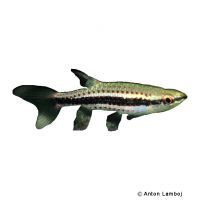Bluespot Copella (Copella nattereri)
| Bluespot Copella Copella nattereri | |
|---|---|
| Name | Bluespot Copella |
| Name Lat. | Copella nattereri |
| Family | Pencilfishes |
| Family lat. | Lebiasinidae |
| Order | Characins |
| Order lat. | Characiformes |
| Origin | South America |
| Habitat | Streams, ponds |
| Diet | Carnivore |
| pH | 4.0-7.0 |
| Behavior | Peaceful |
| Keeping | Group |
| Care Level | Moderate |
| Reproduction | Substrate spawner |
| Breeding | Moderately difficult |
| Life Span | 3-5 years |
| Protection | No |
| Metric Units | |
| Size | 4-5 cm |
| Temperature | 23-28 °C |
| Hardness | 1-5 °dH |
| Aquarium | 60 cm / 54 l |
| US Units | |
| Size | 1.6"-2" |
| Temperature | 73-82 °F |
| Hardness | 18-89 ppm |
| Aquarium | 15 gal |
Distribution and habitat
The distribution area of the Blue-spotted Tetra is the catchment area of the upper Orinoco and Rio Negro in Venezuela and Brazil. They live in slow-flowing, small rivers and forest streams as well as in stagnant waters, such as ponds and floodplains with dense vegetation.
Maintenance
The aquarium should have soft, slightly acidic water and varied planting that provides both shelter and swimming space. A dark substrate covered with some foliage (e.g. sea almond leaves), some roots and shaded light (floating plant cover) is ideal.
No ammonia, ammonium and nitrite should be detectable, the nitrate value should not exceed 100 mg/l. To ensure the water quality and oxygen content, a filter and heater adapted to the aquarium size is required, as well as lighting for the species-appropriate day-night rhythm of the animals.
Diet
In the wild they feed mainly on worms, insects and small crustaceans. The food supply consists of live food, such as cyclops, daphnia, artemia and mosquito larvae, which are also well accepted frozen, plus commercially available frozen special food mixtures. High-quality, protein-rich dry food (flakes, granules) is also usually accepted without problems.
A regular and varied diet promotes health and prevents deficiency symptoms. Only as much should be fed as is eaten immediately (in a maximum of 10 minutes).
Behaviour and compatibility
They are peaceful schooling fish that can be easily socialized with other small and peaceful fish. During spawning season, males consistently defend their territory. At least 5, but preferably more Blue-spotted Tetras should be kept together, with the number of females predominating.
Basically, only mutually compatible fish species with similar demands on water condition and water temperature should be socialized.
Sex dimorphism
Males are more intensely colored, significantly larger, and have a longer extended caudal fin.
Reproduction and breeding
They lay the eggs on a leaf on the water surface (adhesive spawners), which is a little covered by the water (5-10 mm). Once the male has selected a suitable leaf, he forms a territory, which is defended. During courtship, the male pushes a female ready to spawn onto the leaf to lay eggs. After 24-48 hours the larvae hatch and swim free after 3-4 days
Fry must be fed several times a day with special rearing food (dust food). In community tanks breeding is hardly possible, because the young fish are easy prey.
Important
For a long time the red-spotted tetra was mistakenly traded as Copella nattereri. Only in 2006 the red-spotted tetra was described as Copella meinkeni by Zarse & Gery. However, the Copella nattereri with its distinctive deep dark longitudinal band was already described by Steindachner in 1876
The well-being of the fish should be checked regularly. Temperature should be checked daily, pH, hardness and nitrate value at least every 14 days. Regular partial water changes are recommended, even if the contaminant level has not yet reached the upper limit. Sudden changes in water quality should be avoided. Newly introduced fish must be accustomed slowly to the water in the aquarium.
Further literature can be found in your pet store.
References
Text: petdata; Image: Anton Lamboj
Source: BMELV (1998): Tierschutzgutachten - Haltung von Zierfischen (Süßwasser); RIEHL & BAENSCH (2006): Aquarien Atlas Bd. 1, Mergus Verlag; ENGELMANN (2005): Zootierhaltung - Tiere in menschlicher Obhut: Fische, Verlag Harri Deutsch
- Gemäß § 21 Abs. 5 Tierschutzgesetz idgF
